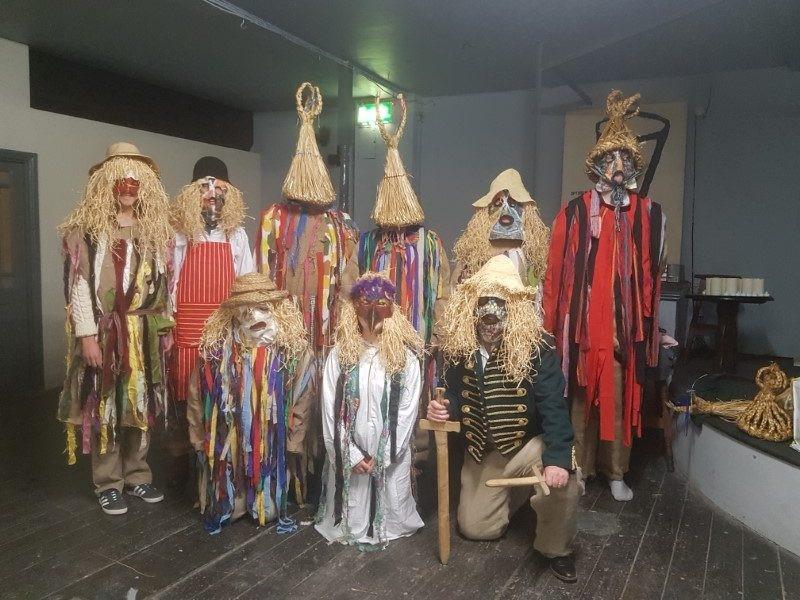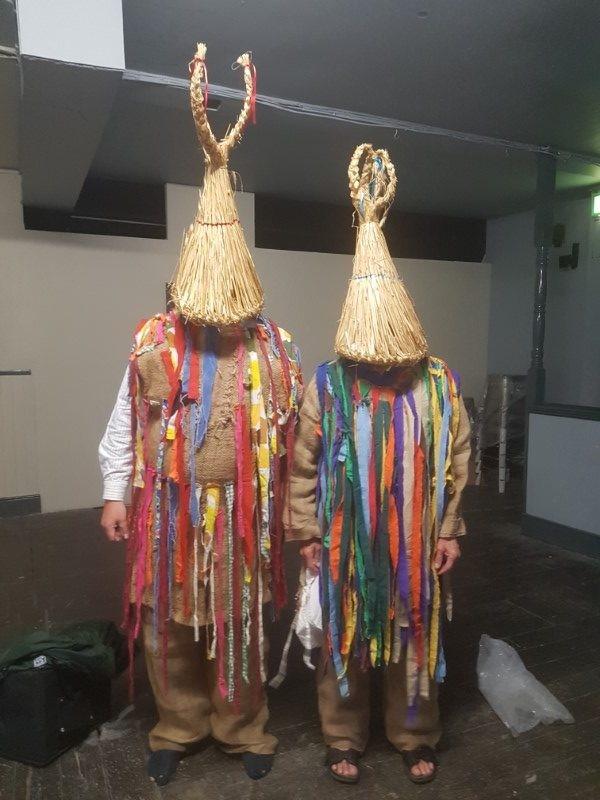Christmas Traditions in Fingal
As we make our way through December and towards the darkest time of the year our anticipation of the Christmas festivities grows. Decorating the tree, indulging in a Christmas feast and exchanging gifts are familiar seasonal rituals to many of us. What is less familiar to us now, however, are the old Christmas customs once practiced in Fingal.

As we make our way through December and towards the darkest time of the year our anticipation of the Christmas festivities grows. Decorating the tree, indulging in a Christmas feast and exchanging gifts are familiar seasonal rituals to many of us. What is less familiar to us now, however, are the old Christmas customs once practiced in Fingal. According to one account:
it used to be a custom in Skerries to go out a week before Christmas, catch a wren alive, put it in a cage, and starve it to death.
When the wren would be dead the men would put it in a crude coffin and carry it from door to door on St Stephen's Day. They used to show it to the people (usually to the women of the house) and sing:-
"The wren, the wren, the king of the birds,
St Stephen's Day he was caught in the furze,
Although he is little, his family's great,
Get up, landlady, and give us a "thrate". (treat)
(SC Vol. 0784: 104-5)
This practice known as ‘catching the wren’ was understood by past generations to ensure prosperity and fertility for themselves and their community for the coming year (Muller 1996/7: 144). It was believed that the wren representing the spirit of the old year was slain to allow for the coming of the new year (Marshall 2003: 62). This ritual was enacted by groups of youths known as ‘wren boys’ who hunted for the wren while beating animal skin tambourines (Evans 1957: 212). Holly was an important part of the ritual with some accounts specifying the wren was killed with a holly stick and was then hung from a stick or bush also usually of holly. The wren boys wore costumes and masks of straw although some accounts have them wearing masks of animal skin or cardboard with long beards of flax or horsehair (Green 1946: 14). These grotesquely dressed characters would then parade the unfortunate wren dangling from bush or pole between households to the accompaniment of musicians and dancers. This procession was enacted to raise money for a wren wake or dance held several days later where young unmarried people came together to dance and make matches. At the end of day, the bird was buried according to human burial rites with the body being coffined and keened (Muller 1996/7: 142). This custom was once widespread and survives today in certain places such as Dingle in Co. Kerry, thankfully however, real birds are no longer used.

The procession of the wren is believed by some to be the leftover of a more elaborate play like the mummer’s play enacted in England (Green 1946: 11). It's thought that the mummer's play dates to early medieval times when guilds would have performed plays throughout the twelve days of Christmas. These plays appear to have been introduced into Ireland in the 17th century taking over aspects of the wren boys’ enactments in some areas especially on the east coast. Mummers plays vary regionally but most consist of a death and a revival believed to symbolise the death of life in winter and its revival in spring (Green 1946: 3). Similar types of traditional plays were enacted in Northern Europe around springtime, leading some to suggest that mummer’s plays were also originally performed at this time of the year. Members of the Fingal Mummers shown in the two images above are part of a long tradition of mumming in North County Dublin. Their plays consist of a range of characters such as the Hero, the Fool, the Giant, the Wise man and the Doctor. An account from Lusk provides an example of the types of rhymes recited by these characters:
Here comes I room rhyme brave gallant boys give us room to rhyme...the sound of a horn the beat of a drum, we are the "mummers" that are to come, we are the mummers that walk the street, we are the mummers that beat all we meet. I and four more bet four score curse, swore, tattered and tore, the devil the like of a beaten they ever got in all their lives before.
Little devil in, little devil out, chawing tobacco in my mouth too much for one too little for two what the devil shall I do. Money, I want and money I crave if you don't give me money I'll put you all in your grave. All silver no brass copper money wont pass.
Here comes I the wren, the wren, the king of all birds. St Stephen's day I was caught in the furze. I dipped my wing in a barrel of beer. I wish you all a happy Christmas and a bright new year. Up with the kettle and down with the pan a shilling or two will bury the wren.
Here come I Tom fool with my big bladder and staff. Ladies and gentlemen sitting round the fire put your hand to your heart and give Tom his desire. I have a little box and it has no tongue nine or ten will do it no wrong, all silver no brass hansel the box and we will all singsongs
(SC Vol. 0786: 188-189)
Traditional Christmas customs preserve important cultural concepts surrounding seasonal change held by past generations. However, the practice of ‘hunting the wren’ reflective of a different relationship with nature than we have today is unnecessary, undesirable and should not be imitated. Instead, the generosity and gifting which form key elements of contemporary Christmas celebrations should be extended to the natural world. Creating a pinecone bird feeder for your garden is a simple way to help garden birds during the harsh winter months. It also provides the opportunity for some cozy Christmas birdwatching! Collecting holly and ivy to create a traditional wreath or to decorate your home is another way to get out and connect with nature this Christmas. You may even spot the elusive wren if you’re lucky!
Delve Deeper
To find out more about the Fingal Mummers check out the websites of Scoil Seamus Ennis and Ireland’s National Inventory of Intangible Cultural Heritage. If you are interested in finding out other ways of helping birds, this Christmas check out the Birdwatch Ireland website here. Or for more Christmas crafts have a look at the Fingal Libraries Youtube channel.
All Images are courtesy of Scoil Seamus Ennis, the Fingal Mummers, and the National Inventory of Intangible Cultural Heritage.
- Aoife Walshe, Swords library.
Bibliography
Evans, Ester (1957), Irish Folk Ways, London.
Green, E.R.R. (1946), ‘Christmas Rhymers and Mummers’. Ulster Journal of Archaeology, Vol. 9, pp. 3-21.
Marshall, Ruth (2003), Celebrating Irish Festivals: Calendar of seasonal events, UK.
Muller, Sylvie (1996/7), ‘The Irish Wren Tales and Ritual. To Pay or Not to pay The Debt of Nature’, Béaloideas, Vol. 64/5, pp. 131-169
Mummers' play. (2000). In I. Ousby (Ed.), The Cambridge guide to literature in English (2nd ed.). Cambridge University Press. Credo Reference: https://search.credoreference.com/content/entry/cupliteng/mummers_play/0?institutionId=913)
Mummers' plays/mumming. (1997). In M. Wynne-Davies (Ed.), The Bloomsbury dictionary of English literature (2nd ed.). Bloomsbury. Credo Reference: https://search.credoreference.com/content/entry/blit/mummers_plays_mumming/0?institutionId=913)
School’s Manuscript Collection, National Folklore Collection, accessed through Dúchas.ie
Wran. (2009). In S. McMahon, & J. O'Donoghue (Eds.), Brewer's dictionary of Irish phrase and fable. Chambers Harrap. Credo Reference: https://search.credoreference.com/content/entry/orionirishpf/wran/0?ins…)